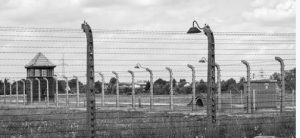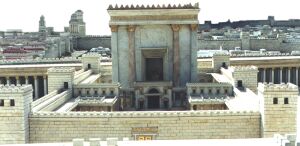
Parashat Mattot And Parashat Masei
In the beginning of Mattot, Hashem asks Moshe Rabbenu to take revenge on the Midianites. However, we see that Moshe delegates this responsibility to Pinchas. There are two reasons for this:
1. Moshe used to live in Midian, and didn’t want to show ingratitude to the people whose land he resided in for many years.
2. Pinchas had already begun the mitzva of killing Midianites with the death of Cozbi bat Tzur, therefore he had to finish the job.
Further, we see that there are only 12,000 soldiers that participate in the battle, as opposed to the battles of Sichon and Og, where all the Israelites fit for fighting participated. We also know that the Midianites were a great and mighty nation. Why the lack of ‘manpower’ on Israel’s part? There is a simple answer – because many of the Israelites had sinned with the Midianite women, and as they were already tainted with sin, it would have been inappropriate to send them into battle with the very nation that ensnared them.
However, the Midrash tells us that another 12,000 were appointed to join Moshe, Aaron and Chur on the mountain top to pray for victory. Why such a large number? Surely half of these people (all of whom must have been righteous) could have joined the others on the frontline? The Holy Zohar tells us that in Heaven the angel of Amalek at that time was arguing against the Jews and trying to incriminate them before Hashem. For this reason, an extra line of defence was required, through prayer.
Hashem called this battle “Israel’s revenge” but Moshe tells the Israelites to “Execute Hashem’s revenge”. The Midrash answers this by saying that Moshe had earlier responded to Hashem that the only reason that the nations pursue the Jews is because of Torah and Mitzvot that He had given us, and subsequently revenge is His.
After the battle, which through a Divine miracle was successful, Moshe Rabbenu expresses his indignation with the soldiers for keeping the Midianite women alive: “Moses was angry with the commanders of the army…Moses said to them…” Why was Moshe’s name mentioned twice? This was because some time elapsed between Moshe’s anger and the statement to the soldiers. The Torah is teaching us an important lesson here – whenever one is angry, one should let his temper subside before talking. One should never speak out of anger.
But why wasn’t Moshe angry with Pinchas? The Midrash Hagadol offers the following explanation. Whenever something improper is done by two parties, and one is greater than the other, only the one of lesser stature should be reprimanded. On hearing the admonition, the greater person will draw the same conclusion. And thus it was with Pinchas and the commanders of his army.
Hashem instructed Moshe to give the Levites part of the spoils of the war. However, in Parshat Korach, Hashem tells the Levites that “a share shall you not have among them”. Chazal tell us that this refers to the spoils of war. Why does Hashem make an exception here? The Midrash tells us that Pinchas had already aroused the indignance of the people, a feeling which undoubtedly extended to the tribe of Levi (who had zealously killed 3000 people after the Golden Calf incident, and also killed seven large families who had previously tried to return to Egypt). This feeling of indignation was brought up again after the war with the Midianites, therefore Hashem told Moshe to give them the spoils to show that the Levites were esteemed.
The next section of the parsha deals with the tribes of Reuven and Gad, who request Moshe for certain areas in the East Bank (Trans-Jordan) for themselves, as these areas were most suitable for their huge flocks of livestock. Moshe explains that this would dishearten the rest of the tribes from crossing into Israel. However, Moshe makes conditions with them that if these tribes join the rest of the Israelites to fight and conquer Canaan, they could have the territories that they requested. But if not, it would be a great sin for them, and they would have to live in Canaan. From here we learn that if one is making tena’im (conditions) it is not sufficient to make it one-way (i.e. just the reward) but two-way (i.e. one must include the penalty as well).
In the Parsha of Masei, we are given a long list of places that the Israelites travelled through on their sojourns in the desert. What was the purpose of this 40-year long trek? Rashi says that it was a means of Hashem publicly praising the Jews for their efforts, trials and tribulations during those years. But why did the Jews go through such an elaborate route and visit so many places? Chazal tell us that one who sees a place where miracles were performed for his ancestors, should make a beracha there. The Torah mentions all these places so that a Jew chancing upon them will be able to bless Hashem for the miracles wrought there.
Maimonides, in his Guide to the Perplexed, offers a different explanation: the desert is a place where no human being would survive after a few days, let alone 40 years. Throughout the sojourn of the Israelites, they didn’t dwell in any habitated places. In short, they had it rough. So as to prevent future generations from believing that the Jews dwelt comfortably, or the manna was a natural product, or that there were wells of water in those places, the Torah enumerates all these places so that in the future people will visit them and learn of the great miracles which Hashem wrought for the Jews for four decades.
For this reason, Joshua said that anyone who would rebuild the fallen walls of Jericho would be cursed. He wanted people to realise that these walls could not have been pulled down by human hands, but had sunk into the ground by a Divine Miracle.
In the travelogue of these journeys we are told that “they [the Israelites] journeyed from Etham and it turned back from Pi Hachirot“. Why are the Israelites described in the second half of this verse as it? The reason is because they turned back with a united heart, and therefore they were described in the singular. But we are told that Pi Hachirot was in fact towards the direction of the advancing Egyptians. How could the Jews be united running towards their pursuers?
At seeing the impending desert and its perils, the Jews were filled with apprehension. When they were commanded to return to Egypt, they were in fact relieved. They thought that perhaps some understanding had been resolved with the Egyptians which would enable them to live in Egypt in peace, and as a result they were more than willing to follow Moshe’s instruction.
On further reading of the travelogue, we see that the date of Aaron’s death is given here. Why here, and not in the Parsha of Chukat when his death actually occurred? The Midrash in Eicha Rabbasa offers an explanation. As we know, every year 15,000 Jews died because of the sins of the spies. This eventually stopped after 40 years – the year of Aaron’s death. However, at that time there were still a number of Jews left who should have been subject to that decree, but Aaron’s death proved an atonement for them and they were forgiven. But the people didn’t realise this at the time. It was only here, in this synopsis (written by Moshe just before his death) that the date is mentioned, intimating that it was due to Aaron that these people were allowed to live.
There then follows a careful delineation of the borders of Israel. Rashi tells us that this is because there are so many agricultural mitzvot only applicable in Israel, so that it was halachically imperative to elucidate these areas thoroughly.
Hashem tells Moshe to command the Israelites to provide the Levites with cities and housing. Surely the Levites, who were to serve in the Temple, and who were the teachers of Klal Yisrael, deserved to be directly provided with shares in the Land? This actually comes to teach us a very important lesson.
This message was to show the ‘students’ that the ‘teachers’ must be supported in all their needs. It was not enough for the Israelites to provide 10% of their produce for the Levites. The Israelites had to be taught that housing was to be provided as well. We must look after our rabbis, teachers and educators not just with money but with raw effort.
The Levites were to be the masters of the 48 Cities of Refuge, where accidental murderers were allowed to live in order to flee from their pursuers (the families of the deceased). Why 48? The Gemara tells us that these places should not be large cities (where a murderer could mingle undetected), nor small villages (where the murderer might not find housing) but medium-sized towns. The Gemara defines this as a town with 500 adult males. The Levites, we are previously told, number 23,000 – therefore (by deft mental arithmetic) they required 46 medium sized villages. What about the other two? They were added to allow for the influx of accidental murderers.
Shabbat Shalom.





